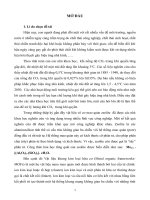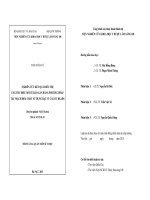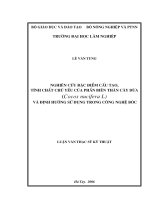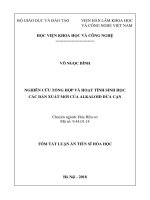70545143 organic II reactions BETA
Bạn đang xem bản rút gọn của tài liệu. Xem và tải ngay bản đầy đủ của tài liệu tại đây (58.23 KB, 8 trang )
Facilitator: Chris Lovero
Organic Chemistry II Reactions
Task
Reaction
Symmetrical
ethers through
dehydration of 1o
alcohols
R OH
H2SO4
x2
140oC
O CH3
Cleavage of ethers
byvstrong acids
Notes
R
*cannot be unsymetrical
O R
(you will get mixtures!)
Br
HBr
*can also use HI, HCl,
+
H3C
Br
etc
* vinyl or aryl do not get
cleaved (NO SN2 ON
SP2)
HBr
Br
O
HO
*basically forms
Autoxidation
R
R O
R
O2 (xs)
H
R O
slow
R
+
R O O
MCPBA
CH3
Intramolecular
Williamson
Br
H
EXPLODE!
CH3
*epoxide will form along
O
the more substituted
CH3
alkene
*SN2 like
O
NaOH
OH
peroxides.... which
R
R
CH3
MCPBA
O OH
R
*forms O- that attacks
halogenated C
OH
NaOH
H3C
H3C
O
Cl
Opening of
Epoxides
CH3
CH3
H3O+
O
D
H2O
CH3
D
OH
2)H3O+
*weak Nu are good
*more substituted side
attacked
D
OH
1)-OH
O
OH
*activate the O first
*SN2 like (least subs)
so strong Nu and base
CH3
D
OH
*Grignard reagent and
acetylide anion can
work tooo
1
Facilitator: Chris Lovero
Organic Chemistry II Reactions
Task
Reaction
Free Radical
Halogenation
Expanded
Notes
*Low T: more stable TS
CH3
NBS
hv 0oC
CH3
CH3
*High T: more stable
Br
compound
CH3
NBS
60oC
transition state
CH3
.
CH3
.
CH3
CH3
CH3
CH3
Br
Conjugated
Systems
*Low T: more stable TS
*in this example we will examine the
case of HBr
*High T: more stable
compound
CH2
H2C
*NOTE: If more than one
H3O+
HBr
conjugated system
Br2
possibly exists, examine
the transition states of
HBr / 40oC
HBr / 0oC
H
each one and do the
reactions with the more
H
stable transtion states!
H2C
Br
Br
transition state
+
Diels-Alder
Reaction
D = donating group
+
*1,2 or 1,4 adduct
W = withdraw group
D
heat
+
*know endo rule
D
*Diene and Dienophile
*Know Stereochem
W
W
D
D
heat
+
W
W
*PRACTICE THIS!!!
2
Facilitator: Chris Lovero
Organic Chemistry II Reactions
NOTE: FROM HERE, YOU HAVE TO KNOW YOUR META, ORTHO, AND PARA DIRECTORS
Task
Reaction
Halogenation of
Benzene
Notes
*X = Cl or Br
X
X2, FeX3 or
(I2 / CuCl2)
Nitration of
Benzene
NO2
HNO3
*H2SO4 acts as a
catalyst
H2SO4 heat
Sulfonation
(fuming sulfuric)
SO 3H
SO3 / H2SO4
*REVERSIBLE DUE TO
ENTROPY
heat
SO 3H
+
H2SO 4
+
H2O
*watch rearrangement!
Friedel-Crafts
Alkylation
R
RCl
*no strong deactivators
(no strong W grps)
*no amino groups
AlCl3
*watch for polyalkylation
Friedel-Crafts
Acetylation
O
O
*no strong deactivators
(no strong W grps)
Cl
R
R
*no amino groups
AlCl3
O
Gatterman-Koch
Formation
(forming
benzaldehyde)
Clemmensen
Reduction
CO / HCl
*no strong deactivators
(no strong W grps)
H
*no amino groups
AlCl3 / CuCl
*avoid using this
O
Zn(Hg)
R
HCl
reactant in the presence
R
of alkenes, alkynes,
alcohols and amines.
3
Facilitator: Chris Lovero
Organic Chemistry II Reactions
Task
Reaction
*Do not confuse with
Reduction of Nitro
group into Amino
Group
Zn, Sn, or Fe
W = withdraw group
X = leaving grp (halide)
NH2
*need Strong W groups
Nu = nucleophile
X
ortho and/or para to
Nu
Nu (2eq)
W
W
Clemmenson Red.
HCl
NO2
Nucleophilic
Aromatic
Substitution of Aryl
Halides:
Notes
leaving group.
W
W
heat, pressure
*Nu can be OH-, RO-,
Addition /
Elimination
NH3.
W
*NOTE: If - OCH3 is the
W
Nu, only need 1 eq
X
Nucleophilic
Aromatic
Substitution of Aryl
Halides:
Elimination /
Addition
OH
*occurs when Strong W
group is not O/P
1) NaOH (2eq) / 340oC / 2500 psi
*formation of benzyne
2) H3O+
in mechanism
X
* Nu can be OH-, RO-,
NH2
NaNH2 /
NH2
+
NH3 (l)
NH2.
*will get a mixture (like
second example)
CH3
CH3
CH3
Chlorination of
Benzene
*8 different stereochems
Cl
actually occur
Cl
Cl
3 Cl2 / heat
pressure
*this particular molecule
is the commercial
Cl
Cl
compound Rid
(lice killer)
Cl
Catalytic
Hydrogenation
-
3 H2 / 1000 psi / 100oC
Ru or Rh (Pt,Pd,Ni also)
Birch Reduction
W
W
*withdraw groups ->
sp3
0
D
Na or Li
0
NH3(l) / ROH
*donating groups ->
D
sp2
4
Facilitator: Chris Lovero
Organic Chemistry II Reactions
Task
Reaction
Side Chain Rxn:
Oxidation
Notes
*Can use either reagent
CO2H
(CH2)n
*Does not work for bulky
KMnO4/H2O
O
groups.
OH-/100oC
HO2 C
CO2 H
CO2 H
Na2Cr2O7 / H2SO4
(no rxn)
heat
Halogenation of
side chains
*If aromatic ring is
Cl
CH2CH3
Cl2 / light
activated, use NBS
+
Cl
54%
44%
Br2 (or NBS) / light
instead of Br2
*Pay attention to Temp
(if it's low or high)
*WILL EXPLAIN THIS
Br
BETTER IN CLASS
Nucleophilic Subs
of Benzylic
Halides
major!
*SN1
CH2 Br
CH3OH
*SN1 or SN2 or E2?
+
Depends on conditions!
heat
*Resonance form that
+
does not disrupt the
CH2 OCH3
aromaticity is more
stable
I
NaI
*SN2
Br
acetone
CH3CH2O-
*E2
Na+
Rxns of phenols
similar to alochols
O
NaOH
-
*2nd rxn is Fischer
Estherification
*3rd rxn is only one that
OH
RCO2H
O
O
or RCOCl
PBr3
R
OH
(no rxn)
is different!
5
Facilitator: Chris Lovero
Organic Chemistry II Reactions
Task
Reaction
Oxidation of
Phenols to
Quinones
HO
Notes
*This reaction forms a
Na2Cr2O7
OH
O
H2SO4
Formation of
Salycilic Acid
*Phenoxide anion can
1) NaOH
OH
OH
O
2) CO2
3) H3O
REVIEW:
Oxidation of
alcohols
D-A dienophile!
O
2o alcohols
react with the weak
OH
electrophile because it
+
is so strongly activated.
*any [ox] can be used
Na2CrO7
*KMnO4 and NO3 can
H2SO4 / H2O
OH
be used but they are
harsh.
O
CrO3 / H2SO4 / H2O
acetone / 0oC
(Jones reagent)
PCC
CH2Cl2
H
1o alcohols
PCC
OH
*Only use PCC because
Jones reagent will
O
yield carboxyllic acid
CH2Cl2
REVIEW:
Cleavage of
Alkenes by
Ozonolysis
H3C
CH3
H
O
R
H2O / H2SO4
R
H
R
+
CH3
O
H
2) (CH3)2S
CH3
REVIEW:
Hydration of
Alkynes
H3C
1) O3
H
CH3
*Really know the
R
CH3
HgSO4
HO
1) Sia2BH
R
2) H2O2 / OH-
H
H
mechanism now
and how the enols
O
tautomerize.
R
1
H
H
RCH2
either
reagent
O
OH
mixture of ketones
6
Facilitator: Chris Lovero
Organic Chemistry II Reactions
Task
Dithiane Synthesis
of Aldehydes and
Ketones
Reaction
Notes
*Dithiane will be given
O
1) BuLi
S
H
S
S
2) R - X
H
R
S
R
HgCl2
H
*BuLi =
H3O+
H
CH3(CH2)2CH2-Li
*Halide must be methyl
or 1o
1) BuLi
2) R1 - X
S
R
Ketones from
Carboxylic Acids
O
R
Ketones from
Nitriles
S
R
1
O
H3O+
R
HgCl2
2) H3O
Aldehydes from
Acid Chlorides
*2 eq because first
is used to make salt
+
R
R
1
O
1) R1-MgX
R C N
1
O
1) R1 - Li (2eq)
OH
R
R
2) H3O+
R
1
*lithium aluminum tri(t-butoxy)hydride
LiAlH(OtBu)3
O
R
O
*Rosenmund Reduction
Cl
R
H2 / Pd / BaSO4 / S
H
*Make sure you know
Ketones from
Acid Chlorides
O
R
O
(R1)2CuLi
R
Cl
how to form Gilman
R
Reagent (refer to Corey-
1
House in previous rxn
sheet)
Wittig Reaction:
Ald and Ketones
ONLY
H
*Know how to prep the
H
phosphorous ylide!
H
O
(Ph)3
*trans is more stable
P C
because you want
+
H
bulky groups to be
furthest away from
each other.
H
H
maj
7
Facilitator: Chris Lovero
Organic Chemistry II Reactions
Task
Aldehydes and
Ketones:
Formation of
Cyanohydrins
Reaction
O
R
*Aldehydes or
OH
-
unhindered ketones
CN
H
R C CN
HCN
*will use this as a
H
reagent in the future.
OH
O
H3CH2C
Notes
NaCN
H3CH2C C CN
H+
H
H
*non AQ favors reactant
Aldehydes and
Ketones: Addition
of 1o Amines
O
RNH2
C
Wolf-Kishner
Reaction
*AQ favors product
C N R
H+
*avoid halogens and
O
NH2NH2
other good LGs.
KOH/DMSO
(Use Clemmensen
instead)
Aldehydes and
Ketones: Addition
of 2o Amines
O
(H3C)2N
(CH3)2NH
H3O+
Acetal Formations
"protected
carbonyls"
CH3
OEt
CH3
2(CH3CH2OH)
H+
O
EtO
*aldehyde protected
*easier to just use
OH OH
O
1) OH
+
HO
before ketone because
CH 3
OH /H
it is more reactive
2) CH3MgBr
H
H
3) H3O+
O
O
O
O
-
CH 3
H
O
O
H
O
O
8









